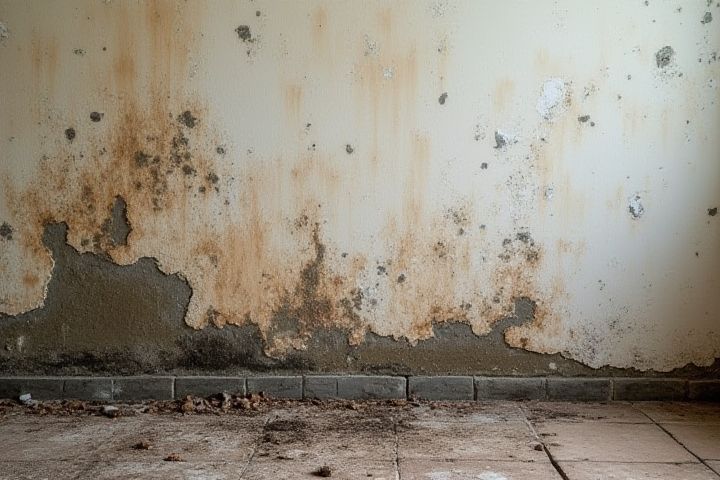
Insuring a house with mold can be challenging, as many insurance companies view mold damage as a pre-existing condition. Insurers often require mold remediation before providing coverage, which can involve professional cleaning and repairs to eliminate the mold source. Some policies may offer limited coverage for mold-related damage, while others may completely exclude it. If you're considering insuring a mold-affected property, it's advisable to consult with insurance agents who specialize in high-risk properties. Understanding your local insurance regulations, as well as remediation options, can help you navigate the process more effectively.
Can I Insure A House With Mold
Specialized coverage may be required
Insuring a house with mold often necessitates specialized coverage, as most standard homeowners insurance policies exclude mold damage. You may need to seek out specific endorsements or policies that provide protection against mold-related issues. To determine the right coverage, consider obtaining a mold inspection, which can cost between $300 and $1,200, depending on the size of your home and the severity of the problem. Understanding your state's regulations on mold insurance can also help ensure you have the necessary protection for your property.
Mold remediation typically necessary
Insuring a house with mold can be challenging, as many standard homeowners' policies exclude mold damage unless specific conditions are met. Effective mold remediation typically involves identifying the source of moisture, removing contaminated materials, and treating affected areas with antimicrobial products. The average cost for professional mold remediation ranges from $1,500 to $3,500, depending on the extent of the infestation and necessary repairs. To increase your chances of obtaining coverage, ensure that the underlying moisture issue is resolved prior to applying for insurance.
Coverage depends on cause
Coverage for mold in your house primarily depends on the underlying cause of the mold growth. For instance, if mold results from a covered peril like a burst pipe, your homeowners insurance may provide compensation for remediation. However, if the mold stems from long-term neglect or maintenance issues, it typically won't be covered. Always check your specific policy details with your insurer to understand the extent of mold coverage in relation to different causes.
Pre-existing mold often not covered
Pre-existing mold is often excluded from many homeowners' insurance policies, making it crucial for you to understand your coverage. Insurance companies typically consider mold a maintenance issue, and they expect homeowners to address moisture problems proactively. A 2019 report indicated that approximately 30% of home insurance claims involve mold-related damage, which underpins the importance of regular inspections. To protect your investment, consider mold remediation measures and consult your insurance provider regarding specific terms related to mold coverage.
Inspection required by insurer
Insuring a house with mold typically requires a comprehensive inspection conducted by a licensed professional, which assesses mold presence and potential damage. Depending on the insurer, you may need to address mold issues before coverage approval. Inspection results will often influence your premium, as insurers may increase rates based on the extent of mold contamination. You may also need to provide documentation that details remediation efforts to secure a policy that adequately protects your home.
Limited endorsement options
Insuring a house with mold can be challenging, as most standard homeowners insurance policies do not cover mold damage without specific endorsements. Limited endorsement options may include additional coverage for damage caused by sudden events, like water leaks, but typically exclude mold resulting from negligence or lack of maintenance. To protect your investment, consider seeking policies that offer mold remediation endorsements, which can cover the associated costs of cleanup and repairs. Always consult with your insurance agent to clarify available options tailored to your property's condition.
Document repairs and remediations
Insuring a house with mold involves documenting all repairs and remediations thoroughly to ensure coverage. Comprehensive records should include photographs, detailed descriptions of the mold removal process, and invoices from licensed remediation specialists. It's crucial to address all underlying issues that contributed to mold growth, such as leaks or humidity problems, as insurers may require proof of these repairs before providing coverage. Always consult your insurance provider for specific requirements and guidelines related to mold damage to avoid coverage gaps.
Higher premiums may apply
Insuring a house with mold issues can significantly increase your premium costs due to the heightened risk associated with mold-related damage. Insurance companies often classify mold as a pre-existing condition, and some may even limit or exclude coverage for mold remediation and damage. In areas prone to humidity, mold can thrive, leading to potential structural damage and health concerns, which might elevate risk assessments. It's crucial to address any mold problems before seeking insurance to mitigate higher costs and ensure comprehensive coverage.
Policy exclusions may exist
When considering insuring a house with mold, it is crucial to understand that many insurance policies explicitly exclude coverage for mold damage. Most standard homeowners insurance policies may not cover mold remediation unless there is a specified peril that caused the mold problem, such as a burst pipe. You should carefully review your policy's exclusions, as mold can lead to substantial health risks and costly repairs. Depending on your state and the insurer, specialized mold insurance or endorsements may be available to provide some level of protection.
Different insurers have varying policies
Different insurers have varying policies regarding coverage for houses with mold, making it crucial to compare options. Some providers may offer mold coverage as part of a standard homeowner's insurance policy, while others might require an additional rider for specific protection. In fact, according to the Insurance Information Institute, nearly 30% of homeowners' policies exclude mold damage altogether. If you are considering insuring a home with existing mold issues, be sure to disclose this information to potential insurers to receive accurate quotes and avoid claim denials.
